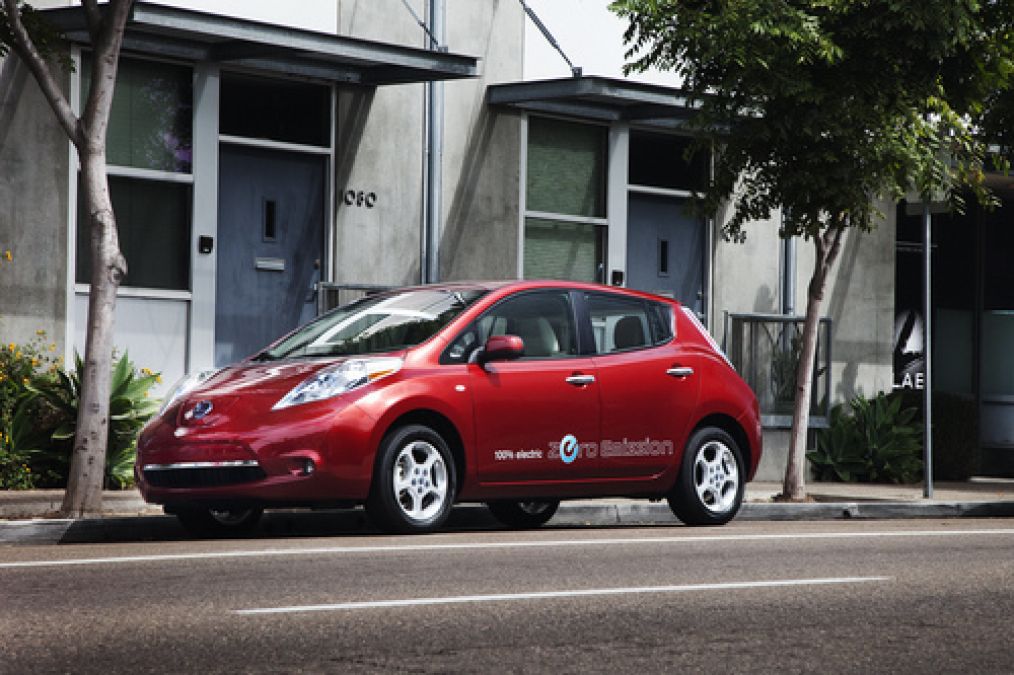The last few months has seen Nissan facing a growing controversy where Leaf owners are reporting a more-rapid-than-expected loss of battery pack capacity. The controversy included a massive test conducted, in Phoenix, independently by Nissan Leaf owners that verified several Leaf's which have a higher-than-expected loss of battery pack capacity. Nissan is working with EV Advocate Chelsea Sexton to form an independent Advisory Board meant as a venue for Leaf owners to help Nissan understand Leaf owner concerns and help Nissan's marketing with communication issues. As a companion to announcing details of the Advisory Board, Nissan published a video interview between Chelsea Sexton and Nissan Executive Vice President Andy Palmer concerning the Leaf battery capacity loss controversy and other issues.
The tone of the interview is somewhat impersonal, as if Nissan wants to project an image of openness.
Battery pack capacity loss issue in Arizona: Saying "lets be straightforward" Palmer says "there is a degradation of a battery over [its] life" and that the degree of degradation over time is a clear matter of physics and chemistry.
The most important thing Palmer says is that the degradation curve is non-linear, or that it does not degrade by the exact same amount each year. The Nissan Leaf owners seem to be expecting a linear degradation of battery pack capacity. Instead there is an initial rapid loss of capacity, and that the rate of capacity loss tapers off over time. This is implied by the shape of the curve Palmer draws in the air with his fingers. This is also implied by saying that after 5 years there will be 80% remaining capacity, and after 10 years 70% remaining capacity, meaning that the rate of degradation is less as the battery pack ages.
The "non-linear" rate of capacity loss is an example of a detail that Nissan did not communicate to Leaf owners.
The four "main" variables for the degradation rate Palmer describes are: "Speed and gradient" the car is driven, meaning that frequent drives at highway speed is bad for the Nissan Leaf battery life, as would be frequent drives in the mountains. "Continuous or very frequent fast charging" will degrade the battery pack, and Nissan recommends at most one fast charge per day. However, this is a direct contradiction of a statement by Mark Perry last spring. He clearly said the Leaf was designed with fast charging in mind, "on a daily basis, 2-3 times a day, with no damage to the battery." "The mileage of the vehicle" or how many total miles it is driven per year. "Temperature, cold and hot" also affect the rate of degradation. Based on the average of Phoenix Leaf owners, who drive on average 7,500 miles/year, in a hot climate, that encourages/requires frequent highway speed driving, Nissan expects that after 5 years in the hands of an average Phoenix Leaf owner, the battery pack will have degraded to 76% remaining capacity. This is is a faster degradation than in other climates.
Most of these variables are essentially described by the phrase "kilowatt-hour throughput" or the total number of kilowatt-hours of electricity processed by the battery pack. Driving fast, driving in the mountains, or driving more miles than average, all involve a higher rate of kilowatt-hour consumption. Palmer mentions the "LA4" driving cycle several times, which is an EPA test protocol meant to simulate city driving at speeds typical of city streets, in the neighborhood of 35 miles/hr. The LA4 driving cycle does not simulate highway driving, and this is what Palmer means when he talks about highway speed driving.
Cost to replace the battery pack: Some Leaf owners are interested in buying a new pack, especially if/when Nissan develops the extremely better battery technology expected within a few years. Palmer describes that Nissan never foresaw that the Leaf owners would want to replace the pack separately from buying a new car. He even suggest that, at this stage of electric vehicle development, it is better to "lease" an electric car rather than buy it outright, because then the risk is placed on the shoulders of Nissan. Nissan, for their part, is confident about the risk. In any case, Nissan designed the business around the only time the customer would replace the battery is if something went wrong with the pack, in which case it would be replaced under warranty.
Palmer positions this question as a task for the Leaf Advisory Board to determine first whether there is a real need for Nissan to sell replacement battery packs. If it is determined, then Palmer says that Nissan will figure out how to do so.
Later in the interview Palmer says that if, in the future, Nissan develops better battery pack technology, that it may be possible to retrofit the newer technology into older cars.
Goodwill efforts: As we noted in a report recently, Nissan bought back two Leaf's from owners who had suffered extreme battery pack capacity loss. Palmer says this is being handled on a customer-by-customer basis.
2013 model year? Palmer says the main focus for the 2013 model year was to "localize" Leaf production to the United States, for sales in America, and in Great Britain, for sales to Europe. The changes to the Leaf for the 2013 model year are minor improvements, because most of the effort was put into setting up localized manufacturing.
Unlike prior attempts by Nissan to talk about this problem, this video is the least nuanced. Nissan's original marketing of the Leaf was to describe it having a 100ish mile driving range, and that battery pack capacity would degrade to 80% over 5 years. Over the last 2-3 years this has become heavily nuanced and increasingly difficult for many to understand the details. As we noted with the a Advisory Board, the controversy has exposed a weakness on Nissan's part in communicating with the public. Perhaps if this quality of communication continues, the public will begin to understand.





